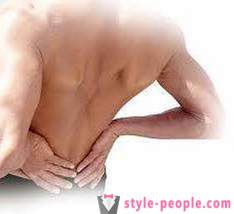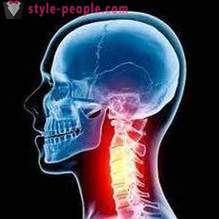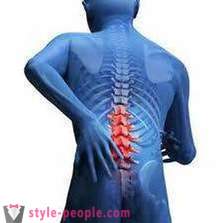Exercises in osteochondrosis of the cervical, thoracic, lumbar and sacral

osteochondrosis in medicine called a chronic disease of the spine. The reason is often a degenerative change in its structure. Most of the adult population - about 80% - suffer from degenerative disc disease. The initial stage of the disease susceptible people from 20 to 30 years, and in older age it appears much stronger. The patient spine, as though it may sound sadly affects the liver, stomach, kidney, leading to serious diseases of internal organs.
To help in this case can physiotherapy. osteochondrosis exercises designed for each spine, and this should be taken into account so as not to harm your health even more. Osteochondrosis is of three kinds: the cervical spine, thoracic and lumbar.
The rules of the complex of exercises
- in osteochondrosis Exercise should be agreed with the doctor in the event that the disease is accompanied by a herniated disc.
- Movement should not cause pain.
- Increase the load gradually.
- If there is pain, then a set of exercises with osteochondrosis should be performed lying down or even abandon it.
- It is not necessary to perform exercises on an empty stomach, on a full stomach, and after physical exhaustion.
- Exercise should develop the muscles, rather than loading the intervertebral discs.
- Do not make sudden movements, everything should be smooth.
Indications and contraindications
Correctly selected exercises with osteochondrosis may help in the treatment of serious diseases. Physical therapy should engage all who have problems with the spine, with the exception of those patients to whom it is contraindicated.
Contraindications:
- hypertension;
- vestibular disease;
- neurological diseases that cause loss of coordination;
- exacerbation of osteochondrosis;
- any disease in the acute stage and impaired general health (remember that exercise in osteochondrosis should only be done with the permission of a competent doctor);
- Early rehabilitation after spinal surgery;
- myopia in heavy stage;
- ocular hypertension;
- cardiac arrhythmia.
In this article we will explain what physical exercise to be performed at an osteochondrosis.
the cervical spine
This is the most common disease of the spine, which affects half the population of our countries. What exercises in osteochondrosis of the cervical spine should perform?

- Take a standing position or sitting on any surface. Hands down dip (along the body). Tilt your head to the right until it stops, and then to the left. Repeat 15 times. The purpose of this exercise is to achieve a degree of mobility and stretching the cervical vertebrae, where the chin and nose as much as possible to be close to the shoulder. It should be noted that the exercise intensity is controlled by the sensation of pain.
- Take the position of sitting or standing. Hands down dip. The head should be (if possible) is pressed against the chest. If the cervical vertebrae are plastic, the jaw can be felt chest cavity. Exercise should be repeated about 5 times. The goal - to make the cervical spine more flexible and stretch the slow-moving large muscles back neck area.
- Take a sitting position. Place one palm on his forehead, tilt the head forward. The hand must exert pressure on the forehead, not letting down my head and forehead seeks to overcome the obstacle. Continue for 12 seconds. Then spend as much time on vacation. Exercise should be repeated at least a dozen times. Objective: To strengthen the weak muscles in the front of the field, ensure the correct position of the neck and increase the mobility of the vertebrae.
The following exercises in osteochondrosis of the cervical spine will help correct posture, typical office workers or people working in writing, and stretch tense muscles.

Take initial position. Move your head back, without raising her chin and pulling. Repeat 12 times. Do this exercise between work every hour. Be sure - the result will be wonderful.
- In the following exercise with cervical osteochondrosis take a standing position. Hands down dip. Lift the shoulders, as if you want to get to the ears. Remain in this position for about 12 seconds. Next lower them slowly, while making a sharp and deep breath. Feel how heavy hand pull your shoulders down. Repeat 12 times.
- The following exercise significantly enhances the lateral neck muscles, reduces pain and improves the mobility of the vertebrae. Take the position of sitting or standing, place your hand on the temples and, bowing his head, start to press. In this case, the head and the hand must counteract each other. Resist about 15 seconds. Spend as much time to rest. Exercise repeat 12 times.
- The position of sitting. Themselves or someone else with the help massage the region between the occipital bone and soft part (muscles). Do this by force, from three to four minutes. The pain in this situation - the norm, but it should be quite tolerant and disappear after a few seconds. Exercise relieves discomfort in the neck.
- The position of sitting. Rub or massage the upper and inner blade region - attaching portion cervical muscle which raises the blade. This exercise can cause short-term pain, which will take place in a few seconds, leaving a slight heat. Continue for about four minutes. It is more expedient to carry out this procedure is not alone, and asked somebody, because massage with efforts to make themselves virtually impossible.
- Take a standing position or sitting. Get both hands behind your head and squeeze it in your hands. Tilt her hand up until not begin to feel light pain. You do not need to apply pressure to the back of the head. The head should fall on their own.
- Do the same, putting his left hand on the right ear. These exercises are performed with cervical osteochondrosis in a fully relaxed state with eyes closed.
- Take the starting position, relax. Imitate the movements of the head figures. To begin get your hands on the score and ten, but with each passing day, "consider" further and further away.
All of the exercises in osteochondrosis of the cervical spine is necessary to control the feelings of pain, otherwise you further do harm to the spine.
How to prevent cervical osteochondrosis?

- For headaches gently massage the temples. It should be done gently in a circular motion in the direction of the eye.
- Be careful not to drafts and hypothermia in the truest sense of the word, as they may lead to an increase in stiffness and tension in the muscles.
- In this disease should not be made head circular motion, as with cervical osteochondrosis it is absolutely contraindicated. Such actions seriously load the lower part of the neck. This can cause damage to the soft tissue and increased pain.
- Do not use without consulting a doctor apparatus for stretching the cervical vertebrae. The spine is very sensitive to any kind of yoga exercises, therefore inaccuracy may lead to serious consequences, in particular, to the separation of the two vertebrae, injuries or damage to the spinal cord.
The osteochondrosis of the thoracic
The pain, which is periodically or regularly appears in the spine at chest level, called the thoracic osteochondrosis. Physiotherapy will ease the discomfort and improve the overall condition of the various stages of the pathological process.
in breast osteochondrosis Exercises

- Take the prone position. The surface should be hard and smooth. Put under mild blade roll diameter of about 10 cm and lift the upper torso. Exercise perform 7 times. Then move the roller over the entire length of the spine and repeat the action. Take the prone position. Stretch your arms forward and lift the upper torso. Over time, this exercise can complicate things by changing the position of the hands. First, try to have them at his head, then place on the back, and then pull the sides.
- The following exercise performed with dumbbells. Take the prone position. Your arms with dumbbells to the sides so that the blades are brought together.
- Take a sitting position. Get your hands behind your head and interlock your fingers. Elbows, try to connect the front. Maximum deploy body in one direction and then in another direction.
- In a standing position, place your hands on your shoulders. Alternately raise them by employing the lateral muscles.
- Take a sitting position on a chair. With all the force at rest against the backrest. Then make leaned forward, trying not to tear the buttocks from the seat, otherwise the exercise will not bring any good. Repeat about 5 times.
- In standing position do side bends. Repeat about 20 times. Perform the exercise smoothly, without sudden movements.
- In the same position, rewound his hands behind his head and repeat.
The following effective exercise of the thoracic spine osteochondrosis help to increase lung ventilation due to the large volume of air exhalation.
- Wrap the lower thoracic area with a cloth or sheet. Print the ends forward. Inhale and exhale. On the exhale, pull strongly on the ends of the sheet so that it squeezed the lower thoracic region.
- Take a position on all fours. Exhale while lowering his head and arching his back up. On the inhale - on the contrary. Repeat the exercise 12 times.
Perform regular exercises in osteochondrosis of the thoracic - and the results will not keep you waiting long.
Prevention
In order to protect themselves from this disease, it is necessary to closely monitor the correct posture and maintaining pectoral muscles toned. The shoulders should be straightened, back straight. Exercises with the cervical-thoracic osteochondrosis.
- Take the position of sitting or standing. Place a hand on his cheek. Start tilting your head to the side and hand to resist. Do this for about 12 seconds. Exercise repeat 12 times. Objective: To strengthen the side of the neck muscles.
- Take a standing position. Head and hands lower down. Uprites door-to-end along the entire length of the spine interscapulum. Gently unbend head, looking away with the shoulders back until the end until the doors will not touch your crown, and his shoulders have withdrawn as much as possible. All these actions are performed on the breath. On the exhale, return to the starting position. Repeat 7 times. Rest between exercises for 12 seconds. Objective: To strengthen the muscles, improve blood circulation and mobility in the joints of the thoracic.
- Take a sitting position. Hands down and cross to the castle. When you inhale, tilt the torso and head to the side. When you exhale, return to the starting position. Objective: To strengthen the muscles of the back, neck, improve blood circulation, joint mobility, ribs have.
Lumbar osteochondrosis. Exercises

A set of exercises with lumbar osteochondrosis to be performed carefully. If you feel pain, stop immediately and switch to another position.
- Take a position lying on the back. Bend your legs, feet leave the floor. Lift the pelvis. Try to shift the whole burden on the thoracic spine. Repeat about 20 times. Relax, making a couple of deep breaths.
- Take a position lying on the back, repeat the first exercise, putting a small cushion under the lower leg. Lift the pelvis. You do not need sharpening, since it can be quite painful for untrained muscles.
- In the supine bend your legs at the knees. Tighten your abdominal muscles by lifting your head at the same time. Hold this position for 12 seconds, relax. Repeat 7 times.
Here's another no less effective exercise in osteochondrosis of the lumbar.
- Take a position lying on the back. The legs should be straight. Tighten your buttocks and hold this position for 7 seconds. Repeat 12 times.
- In the supine, get your right hand behind your head and try to get an elbow to the left knee. After performing the change leg and arm. Repeat in each direction 10 times.
- Take a standing position. Raise your hands up and starts to sag back. Should not perform this exercise if there pain, as well as during the acute illness.
- In a standing position follow a circular motion around the body. Do 10 sets in one direction and 10 in another.
The following exercises with lumbar osteochondrosis are allowed to do, and in the acute phase of the disease.
- Take the prone position. First, bend your legs at the knees and then straighten them, slowly sliding feet on the surface. Repeat 12 times.
- supine. Leg bend at the knee and press her hands to her chest. For each leg exercise should be repeated 12 times.
Exercise pain in lumbar osteochondrosis
It should be remembered that all the exercises that help with pain in the spine, must obtain the approval of a doctor, otherwise it can lead to more serious consequences. What exercises in osteochondrosis of the lumbar help with pain?

- Lying on your back, try to go all out to pull the spine without using their hands. Repeat 15 times.
- In the same position flexes his whole body up as much as possible. Repeat about 5 times.
- In a prone position on his back, stretch your arms up and stretch yourself struggling. Hold this position for half a minute. Take rest. Repeat in 3 sets.
- In the same position, hands apart. Of all the forces trying to pull. Next, lower your arms. Repeat the exercise 12 times.
The next set of exercises in osteochondrosis of the lumbar performed in a standing or sitting position.
- put your hands up, try my best to pull the spine. Hold for thirty seconds. Dip your hands. Relax. Repeat 3 times.
- Press the back against the wall. Try to push it away from you, using all the power. Hold for thirty seconds. Repeat 3 times.
- Hang on a horizontal bar. Relax. Powys about one minute. Repeat 7 times.
sacral
Exercises in osteochondrosis of lumbosacral department aimed at normalizing the tone of back muscles and improve flexibility of the spine.

- Take a kneeling position. When you inhale arch your back and lift your head, exhale return to the starting position.
- Inhaling pull the leg and head up, exhale return to the starting position.
- In the position on his knees, place your hands on the floor. Lower your head and make your back arched. On the inhale bend your arms, forearms touch the floor and pull the leg back, raising her at the same time in the cave in the back. On the exhale, return to the starting position. The same actions done with the other leg.
- Extend your right leg and your left hand on the inhale. On the exhale, return to the starting position. The same thing happened with the next leg.
- In the position of kneeling inhale and move the pelvis back. Sit on your heels and lower your head down between his hands. On the exhale, return to the starting position.
- Lean on your hands. Inspiratory arch your back, bending the arm at the same time. On the exhale, return to the starting position.
- Take a breath and touch the floor feeding, raising at the same time the head. On the exhale, return to the starting position.
Of course, plodding life seriously affect our health. It has long been known that the sport - it's life. The basic rules for the prevention of degenerative disc disease of the spine is a regular walk in the fresh air and active lifestyle. Follow these recommendations - and the disease will pass. Well, if you still trouble you touched, the exercises listed in spinal osteochondrosis help without fail. Importantly, implement them consistently and correctly. It's better if you do the exercises under the supervision of a physician who will be able to match you with the optimum range.













































